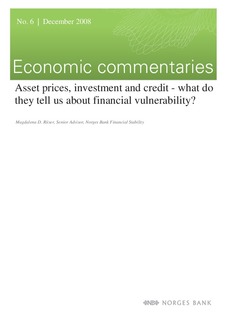| dc.contributor.author | Riiser, Magdalena D. | |
| dc.date.accessioned | 2018-08-23T07:39:10Z | |
| dc.date.available | 2018-08-23T07:39:10Z | |
| dc.date.issued | 2008 | |
| dc.identifier.uri | http://hdl.handle.net/11250/2558950 | |
| dc.description.abstract | In this commentary we examine whether a number of historical indicators can predict financial vulnerability over the past 150 years in Norway. Using a Hodrick-Prescott filter, we estimate the gap between actual observations and the trend for real house prices, real equity prices, gross fixed capital formation and credit on Norwegian data back to 1819. We find that all the gap indicators are useful in predicting earlier episodes of financial instability in Norway. The indicators show with few exceptions a common pattern, with widening gaps in the six years ahead of the banking crises, and a subsequent fall. As a rule, at least two of the gap indictors have high values ahead of the banking crises, suggesting that combinations of indicators may strengthen the analysis. The indicators point to an increase in financial vulnerability in 2007. | nb_NO |
| dc.language.iso | eng | nb_NO |
| dc.publisher | Norges Bank | nb_NO |
| dc.relation.ispartofseries | Economic Commentaries;6/2008 | |
| dc.rights | Attribution-NonCommercial-NoDerivatives 4.0 Internasjonal | * |
| dc.rights.uri | http://creativecommons.org/licenses/by-nc-nd/4.0/deed.no | * |
| dc.title | Asset Prices, Investment and Credit – What Do They Tell Us About Financial Vulnerability? | nb_NO |
| dc.type | Others | nb_NO |
| dc.description.version | publishedVersion | nb_NO |
| dc.subject.nsi | VDP::Samfunnsvitenskap: 200::Økonomi: 210::Samfunnsøkonomi: 212 | nb_NO |
| dc.source.pagenumber | 6 | nb_NO |

